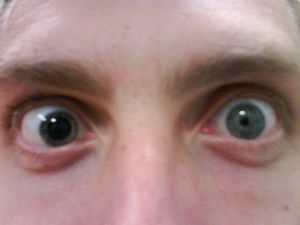

MedFriendly®


Anisocoria
Anisocoria is a condition in which the pupils of the
eyes are not of equal size.
WHAT IS THE PUPIL?
The pupil is the black circle in the middle of each eye
that responds to light. The pupil gets wider when there
is less light in order to increase the amount of light that
enters the eye. The pupil narrows when there is more
light in order to decrease the amount of light that
enters the eye.
FEATURED BOOK: Principles of Neurology
WHAT CAUSES ANISOCORIA?
There are many possible causes of anisocoria, some of which are listed below:
SIMPLE ANISOCORIA: One of the most common causes is called simple anisocoria.
Simple anisocoria is seen in 20% of normal people and thus, is not a problem. In simple
anisocoria, the pupils are different by a size of 0.3 and 0.5 millimeters. A millimeter is a
very small unit of length equal to .0394 inches. The pupil sizes in such individuals
commonly change from day to day and even from hour to hour. Often, the anisocoria is
not present when doctors reevaluate such patients.
"Where Medical Information is Easy to Understand"™
HORNER'S SYNDROME: If the problem is an abnormally small
pupil, this indicates Horner's syndrome. Horner's syndrome is a
group of physical signs that affect one side of the face and
suggest damage to part of the sympathetic nervous system. The
sympathetic nervous system is the part of the nervous system that
generally excites the body by doing things such as increasing both
the heart rate and blood pressure. Besides the small pupil,
drooping of the eyelid and absence of sweating is seen in Horner's
syndrome. Damage or destruction to sympathetic nerve fibers,
usually in the neck, is what causes Horner's syndrome. In the case
of Horner's syndrome, the smaller pupil will take longer to increase
in size in response to darkness.

THIRD NERVE PALSY: This is an interruption in the fibers in the third cranial nerve (known as the
oculomotor nerve). Cranial nerves are nerves that emerge from the brain. The oculomotor nerve
supplies the muscle that narrows the pupil. Thus, if the oculomotor nerve is damaged, the affected pupil
will be increased in size because the oculomotor nerve will not be able to narrow the pupil as
effectively.
ADIE PUPIL: This is a condition in which there is degeneration of nerve fibers to the eye and of a small
nerve cell body called the ciliary ganglion. The ciliary ganglion helps control the pupil movements. In
cases of Adie pupil, the affected pupil will be increased in size.
STROKE: A stroke is a burst artery or a blockage of an artery in the brain. An artery is a type of blood
vessel that carries blood away from the heart. Anisocoria is known to result from strokes, depending on
where the stroke is located in the brain. Anisocoria is often found in strokes of the pons. The pons is a
part of the brainstem that is very important for sleep and arousal. The brainstem is an area in the lower
part of the brain that connects it with the spinal cord. Other common stroke symptoms include motor
difficulties on one side of the body, visual disturbances, difficulty speaking, sudden headache, and loss
of consciousness.
MEDICATIONS: Certain medications can cause unequal pupil sizes. This is especially true for
medications that mimic the effects sympathetic nervous system. The sympathetic nervous system is
the part of the nervous system that generally excites structures and organs in the body by doing things
such as increasing both the heart rate and blood pressure.
In this case of anisocoria, one
pupil is much larger than the other.














